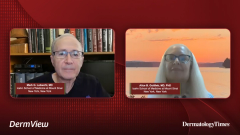
Managing Candidiasis Associated With IL-17 Inhibitors in Plaque Psoriasis
Expert dermatologists discuss the risk of candidiasis with IL-17 inhibitors when managing plaque psoriasis and how to manage candidiasis.
Episodes in this series

Mark G. Lebwohl, MD: On the adverse effect side of IL-17 inhibitors, there are increased rates of candidiasis in virtually every drug in every study. As you know, people born deficient in IL-17 or its receptor develop chronic mucocutaneous candidiasis. They don’t get more cancers. They don’t get more heart attacks. They get yeast infections. Data from the BE VIVID and BE RADIANT trials of bimekizumab suggest that candidiasis may be more common with that drug compared with secukinumab and ustekinumab. The rate we see with secukinumab and adalimumab is somewhat lower as well. To what extent should the risk of candidiasis and other adverse events shape treatment selection?
Alice B. Gottlieb, MD, PhD: My first comment—it sounds a bit glib, but it’s true—is that there’s more candidiasis because it works better. That might sound like a glib answer, but it’s true. It affects my discussion with the patient. I tell them that we’re experienced, and it can easily be handled. I don’t think I’ve ever had a patient not take IL-17 blockers because of the risk of candidiasis. It would be useful, especially for rheumatologists, other specialists, and primary care nurse practitioners, to get a cheat sheet that says what you do when you have this kind of candida or when you have another kind of candida. Then it becomes a nonissue. For me, it’s not a major issue. It’s a rare patient for whom this becomes an issue.
Mark G. Lebwohl, MD: I agree. If you look at the data from those trials, the cases of candida were overwhelmingly mild to moderate. They didn’t result in patients dropping from the study because they were thrilled with the outcomes in terms of their psoriasis and psoriatic arthritis. The question has been raised: are the candida infections recurrent? The vast majority were 1 or 2 episodes. It was uncommon to get 3 to 5 and rare to get more than 5 episodes of monilia infections. These are easily manageable. Most of the candida that was seen was thrush or oral pharyngitis candida pharyngitis. The genital candidiasis, which we have seen with the other IL-17 blockers in our practice, are so easy to treat. In the United Kingdom and in Canada, fluconazole is over the counter and a single 150-mg dose is published as adequate to treat genital candidiasis. For thrush and for oral pharyngitis, April Armstrong recently published a good review article in which she suggested that, depending on the patient’s weight, 1 to 200 mg a day for 1 to 2 weeks of fluconazole works. Until I read that article, I was treating everyone with 150 mg of fluconazole for 3 days for oral candidiasis. I never saw failure. There is Mycostatin mouthwash, and sucking on antifungal troches has been used, but oral fluconazole is an easy treatment.
Transcript Edited for Clarity
Newsletter
Like what you’re reading? Subscribe to Dermatology Times for weekly updates on therapies, innovations, and real-world practice tips.



















